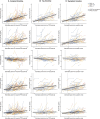Timing of Changes in Alzheimer's Disease Plasma Biomarkers as Assessed by Amyloid and Tau PET Clocks
- PMID: 40539416
- PMCID: PMC12335434
- DOI: 10.1002/ana.27285
Timing of Changes in Alzheimer's Disease Plasma Biomarkers as Assessed by Amyloid and Tau PET Clocks
Abstract
Objective: The objective of this study was to evaluate the timing of change of Alzheimer's disease (AD) plasma biomarkers (Aβ42/Aβ40, p-tau217, p-tau181, GFAP, and NfL) from six different assay platforms, alongside established AD biomarkers, using amyloid and tau positron emission tomography (PET)-based AD progression timelines.
Methods: Data from the Alzheimer's Disease Neuroimaging Initiative (ADNI), including 784 individuals with longitudinal amyloid PET and 359 with longitudinal tau PET, were analyzed to estimate the age at amyloid and tau PET positivity, respectively. Longitudinal plasma biomarker measurements were available from 190 individuals with an estimated amyloid PET positivity age and from 70 individuals with an estimated tau PET positivity age. In a subset of 17 clinical progressors, age at tau PET positivity strongly predicted symptom onset, allowing for estimation of symptom onset age. Biomarker trajectories based on time from amyloid or tau PET positivity or symptom onset were modelled using Generalized Additive Mixed models. Time intervals of significant biomarker change and the earliest timepoints at which biomarkers exceeded predefined abnormality thresholds were identified.
Results: All plasma biomarkers except NfL became abnormal prior to established thresholds for amyloid and tau PET positivity. Plasma Aβ42/Aβ40 became abnormal very early in both amyloid PET and tau PET timelines, while plasma GFAP became abnormal early in the tau PET timeline. Plasma Aβ42/Aβ40 levels plateaued, whereas plasma p-tau217, p-tau181, GFAP, and NfL levels increased throughout the modeled disease progression. Some variations in the timing of these changes were observed across different biomarker assays.
Interpretation: These findings suggest that the plasma Aβ42/Aβ40 may be useful in identifying individuals with very low levels of amyloid pathology, whereas p-tau, GFAP, and NfL may be useful in staging disease progression. ANN NEUROL 2025;98:508-523.
© 2025 The Author(s). Annals of Neurology published by Wiley Periodicals LLC on behalf of American Neurological Association.
Conflict of interest statement
H.K. has served on scientific advisory boards and/or as a consultant for ALZpath and Roche, and has given lectures sponsored by Fujirebio and Roche. J.L.D. has/is served/serving as a consultant or on advisory boards for AlzPath Inc., and Quanterix. J.L.D. has received research support from Fujirebio and Roche Diagnostics in the past 2 years. J.L.D. has stock or stock options in AlzPath Inc. Y.L. is the co‐inventor of the technology “Novel Tau isoforms to predict onset of symptoms and dementia in Alzheimer's disease” which is in the process of licensing by C2N. N.J.A. has received speaking fees from Quanterix. These conflicts involved companies that are developers of the assays used in the study. S.E.S. has served on scientific advisory boards on biomarker testing and education for Eisai and Novo Nordisk and has received speaking fees for presentations on biomarker testing from Eisai, Eli Lilly, and Novo Nordisk. M.M.A., D.T., I.H., K.K.P., L.D.C., Z.S.S., B.S., G.T.B., D.L.R., J.C., M.B., E.A.M., Y.M., C.E.R., K.F., H.K., E.G.R., M.S., L.M.S., A.W.B., and W.Z.P. have nothing to report. [Correction added on 12 July 2025, after first online publication: The following text “S.E.S. has served on scientific advisory boards……. Novo Nordisk.” has been added in this version.]
Figures




Update of
-
Timing of changes in Alzheimer's disease plasma biomarkers as assessed by amyloid and tau PET clocks.medRxiv [Preprint]. 2024 Nov 14:2024.10.25.24316144. doi: 10.1101/2024.10.25.24316144. medRxiv. 2024. Update in: Ann Neurol. 2025 Sep;98(3):508-523. doi: 10.1002/ana.27285. PMID: 39574864 Free PMC article. Updated. Preprint.
References
MeSH terms
Substances
Grants and funding
- a public-private partnership managed by the Foundation for the National Institutes of Health/Biomarkers Consortium, Plasma Aβ and Phosphorylated Tau as Predictors of Amyloid and Tau Positivity in Alzheimer's Disease Project
- U24 AG021886/AG/NIA NIH HHS/United States
- R01 AG070941/AG/NIA NIH HHS/United States
- R01AG070941/AG/NIA NIH HHS/United States
- U19 AG024904/AG/NIA NIH HHS/United States
LinkOut - more resources
Full Text Sources
Medical
Miscellaneous

